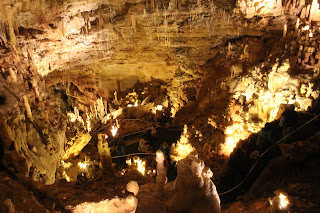We explored the square in front of the Alamo before beginning our guided tour, and examined the enormous memorial in front of the long barracks.
Every confirmed defender who died defending this ground has their name engraved on it in alphabetical order. You can't really help but be drawn to the truly legendary ones though: Commander William Travis is really only known because of the Alamo, but ex-Congressman and frontiersman Davey Crockett and renowned knife fighter Jim Bowie had larger-than-life reputations well before meeting their end here.
Should you ever visit, take the tour. Our guide was a font of information, and passionate about sharing her Alamo lore. She explained how the Alamo was more or less the middle of the Texas Revolution, and how it had kicked off when the small town of Gonzales dared General Santa Anna to follow through on his threat to reclaim the cannon left there to defend against raiders. Their taunting flag, echoing the sentiment of the Spartans at Thermopylae, is displayed in many yards in Gonzales to this day.
It seems unlikely anyone would have chosen the Alamo as the place to fight such a signature battle, but they did.
The flags of six different countries have flown over Texas in its turbulent history, from Spain and Mexico, and even five years under France before returning to Mexico prior to becoming an independent republic. The Confederate States of America and United States of America round out the field.
Even our brief visit was enough to give us a little better understanding as to why our southern neighbours, and most especially Texans, can seem to get so hung up on the notion of liberty; it's because throughout most of their history, they've had to fight for it. People with no real stake in the game had to come to the Alamo from as far away as Tennessee in order to help a fledgling nation maintain its freedom. Inside the church, numbered ribbons attached to flags solemnly tell how many volunteers came from each state (and some other countries too) to die at the Alamo.
The Battle of the Alamo is a fascinating if tragic tale, with roots that touch upon how Spain used the Catholic church to advance it's cause around the globe and into the new world; the rise of Napoleon and the deposing of the Spanish king; the resulting independence of most of Central and South America; and carrying through to modern Texas as the only state in the union which was once an independent republic.
Anyone intrigued by history or sacrifice would do well to stop in on this piece of the past so diligently maintained in the middle of downtown San Antonio.






























































